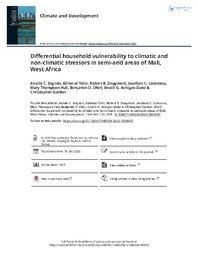UGSpace Repository
Differential household vulnerability to climatic and non-climatic stressors in semi arid areas of Mali, West Afric
JavaScript is disabled for your browser. Some features of this site may not work without it.
| dc.contributor.author | Segnon, A.C. | |
| dc.contributor.author | Totin, E. | |
| dc.contributor.author | Zougmoré, R.B. | |
| dc.contributor.author | Lokossou, J.C. | |
| dc.contributor.author | Thompson-Hall, M. | |
| dc.contributor.author | Ofori, B.O. | |
| dc.contributor.author | Achigan-Dako, E.G. | |
| dc.contributor.author | Gordon, C. | |
| dc.date.accessioned | 2022-01-19T10:59:54Z | |
| dc.date.available | 2022-01-19T10:59:54Z | |
| dc.date.issued | 2021 | |
| dc.identifier.other | https://doi.org/10.1080/17565529.2020.1855097 | |
| dc.identifier.uri | http://ugspace.ug.edu.gh/handle/123456789/37706 | |
| dc.description | Research Article | en_US |
| dc.description.abstract | Semi-Arid Regions (SARs) of West Africa are considered climate change “hotspots” where strong ecological, economic and social impacts converge to make socio-ecological systems particularly vulnerable. While both climatic and non-climatic drivers interact across scales to influence vulnerability, traditionally, this inter-connectedness has received little attention in vulnerability assessments in the region. This study adopted the vulnerability patterns framework, operationalized using the Multidimensional Livelihood Vulnerability approach to include both climatic and non climatic stressors to analyze differential household vulnerability in SARs of Mali. Findings showed that while drought was the most mentioned climate-related stressor, households were also exposed to a diversity of environmental and socio-economic stressors, including food scarcity, livestock disease, labour unavailability, crop damage, and erratic rainfall patterns. The typology revealed three vulnerability archetypes differentiated by adaptive capacity and sensitivity. Availability of productive household members, household resource endowments, livelihood diversification and social networks were the main discriminant factors of household adaptive capacity, while challenges relating to food and water security make households more sensitive to stressors. The analysis highlighted the heterogeneity in household vulnerability patterns within and across communities. Failing to account for this heterogeneity in adaptation planning might result in a mismatch between adaptation needs and interventions, and potentially in maladaptation. | en_US |
| dc.language.iso | en | en_US |
| dc.publisher | Taylor & Francis Group | en_US |
| dc.subject | vulnerability patterns | en_US |
| dc.subject | archetype analysis | en_US |
| dc.subject | vulnerability assessment | en_US |
| dc.subject | multiple stressors | en_US |
| dc.subject | heterogeneity | en_US |
| dc.subject | adaptive capacity | en_US |
| dc.subject | semi-arid regions | en_US |
| dc.title | Differential household vulnerability to climatic and non-climatic stressors in semi arid areas of Mali, West Afric | en_US |
| dc.type | Article | en_US |
